Tom's Hardware Verdict
The Microsoft Surface Laptop 3 (15-inch) is an attractive, thin 15-inch notebook -- and it finally has USB Type-C. But its performance and battery life are lacking.
Pros
- +
3:2 display
- +
Attractive, lightweight design
- +
No longer glued together
- +
Finally has USB Type-C
Cons
- -
Below-average battery life
- -
Very few ports for the size
- -
Middling performance
- -
Expensive for what you get
Why you can trust Tom's Hardware
Microsoft’s Surface Laptop 3 represents a lot of firsts. The laptop ($1,699.00 as tested; $1,199.00 to start) is the first Surface with an AMD Ryzen processor, the first 15-inch in the Surface Laptop line and the first Surface Laptop to ditch Alcantara fabric. It’s also the first that’s not glued together.
And while it may just look like a bigger Surface Laptop (compared to the 13-inch models that have been around a few years now), there are lots of other changes, including the Wi-Fi chip and the introduction of USB Type-C. But there’s also some hurdles here in terms of battery life, port selection and performance.
(If you prefer a 2-in-1, we also reviewed the Microsoft Surface Pro X with an ARM chip, the Microsoft SQ1.)
Design
At first glance, the 15-inch variant of the Surface Laptop 3 looks like the company just took the 13-inch version and stretched it. But I’ve grown to appreciate the design in different ways.
On top, yes, it looks identical. The lid is a big, black, aluminum rectangle with the Microsoft logo in the center. (You can also opt to get the 15-inch version in platinum).
When you lift the lid, the 15-inch display is surrounded by a fair bit of bezel, but not so much to be abhorrent. The display is tall (see the Display section, below) with a 3:2 aspect ratio, making the laptop deeper front to back than some others.

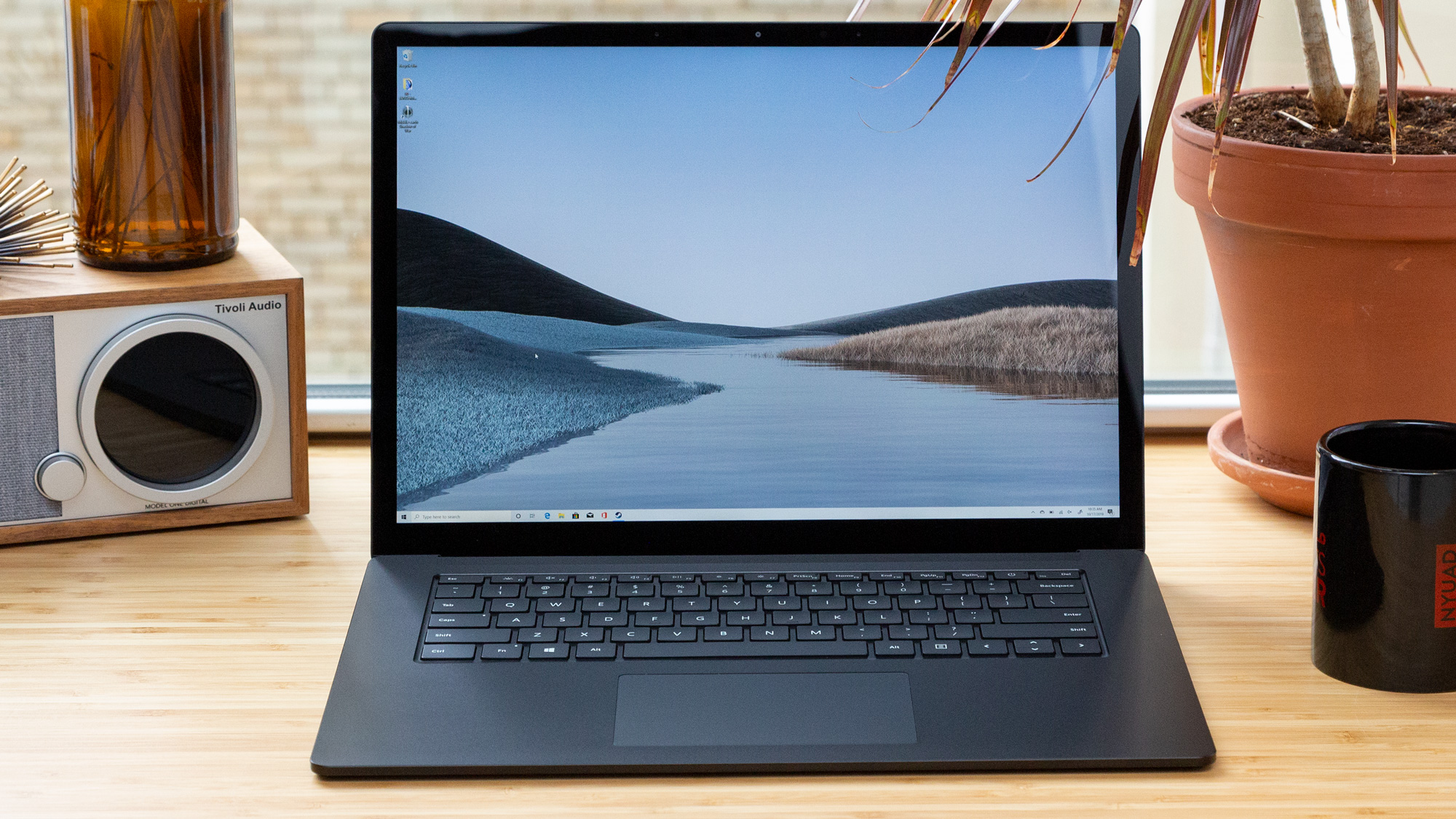

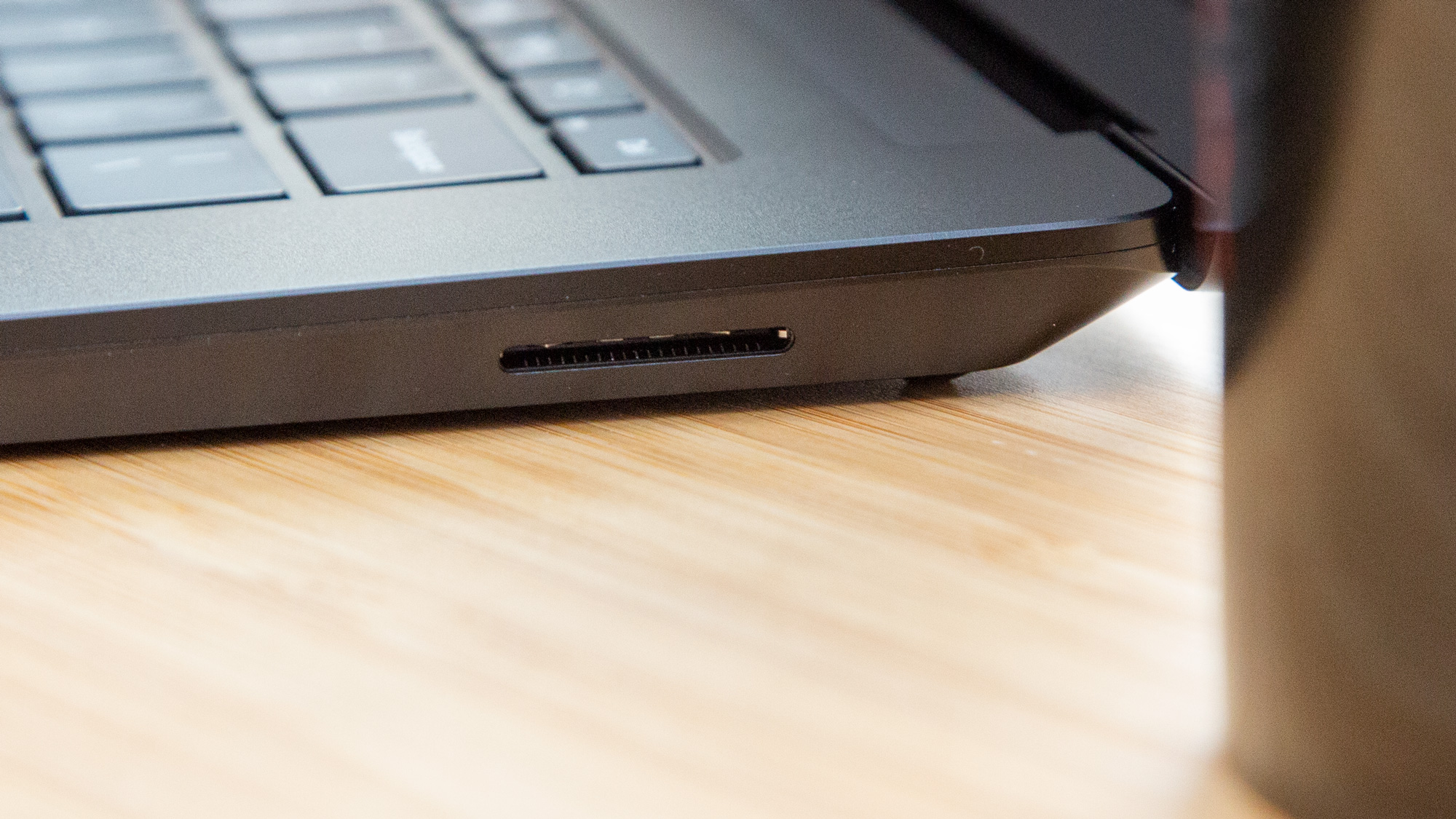
The deck is also plain black aluminum. Microsoft has removed the Alcantara fabric from previous 13.5-inch models of the Surface Laptop 3 on this one, making for a very spartan appearance. It’s both here and on the lid where one thing becomes obvious: The Surface Laptop 3 is a fingerprint magnet. You may not have to worry about keeping the Alcantara clean, but you’ll definitely want to wipe the deck and the lid on occasion to keep the laptop looking clean.
Perhaps the best thing about the Surface being so similar to its 13-inch siblings is that it has maintained its slenderness. The laptop is 3.4 pounds and 13.4 x 8.6 x 0.6 inches (339.5 x 244 x 14.7 mm). It’s really easy to throw in a backpack and forget about, which is very rare for a 15-inch notebook.
The Dell XPS 15 is heavier at 4.5 pounds and slightly larger overall at 14 x 9.7 x 0.7 inches. The 14-inch ThinkPad X1 Carbon is lighter at 2.4 pounds and measures 12.7 x 8.6 x 0.6 inches.
Get Tom's Hardware's best news and in-depth reviews, straight to your inbox.
One big letdown with the design are the ports -- or lack thereof. On the left side there’s a USB Type-C port -- finally, though it’s not Thunderbolt 3. That’s joined by a USB Type-A port and a 3.5mm headphone jack. On the right side, the sole port is the proprietary Surface Connect port, which you use for charging and connecting to Microsoft’s own dock, should you choose to buy it. The good news is, if you do want to charge over USB Type-C, that will work too, provided you bring your own compatible charger.
But there’s plenty of extra room on the edges of the chassis, and it’s a shame there aren’t more ports here. At least one more USB-C or USB-A port on the right edge would have been much appreciated.
Specifications
| CPU | AMD Ryzen 5 3580U (Microsoft Surface Edition) |
| Graphics | Radeon Vega 9 (integrated) |
| Memory | 16GB DDR-2400 |
| Storage | 256GB PCIe NVMe SSD |
| Display | 15-inch, 2494 x 1664 touch screen with 3:2 aspect ratio |
| Networking | Qualcomm Atheros QCA61x4A |
| Ports | USB Type-C; USB Type-A; 3.5mm Headphone jack; |
| Camera | 720p webcam |
| Battery | 45.8 Whr |
| Power Adapter | 65W |
| Operating System | Windows 10 Home |
| Dimensions (WxDxH) | 13.4 x 9.6 x 0.6 inches (339.5 x 244 x 14.7 mm) |
| Weight | 3.4 pounds |
| Price (as configured) | $1,699 |
Productivity Performance
The 15-inch Surface Laptop is a bit of a watershed moment for AMD. It’s a big-name, high-end productivity laptop boasting one of its Ryzen flagship processors. Specifically, our review unit has a “Microsoft Surface Edition” AMD Ryzen 5 3580U, paired with 16GB of RAM and a 256GB PCIe SSD.
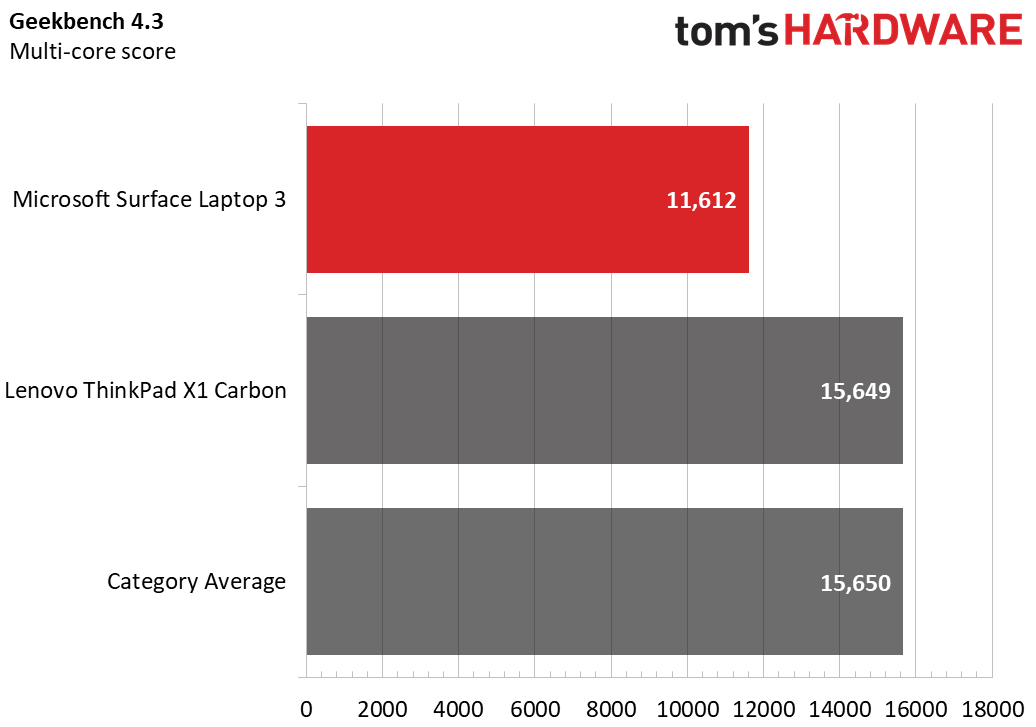
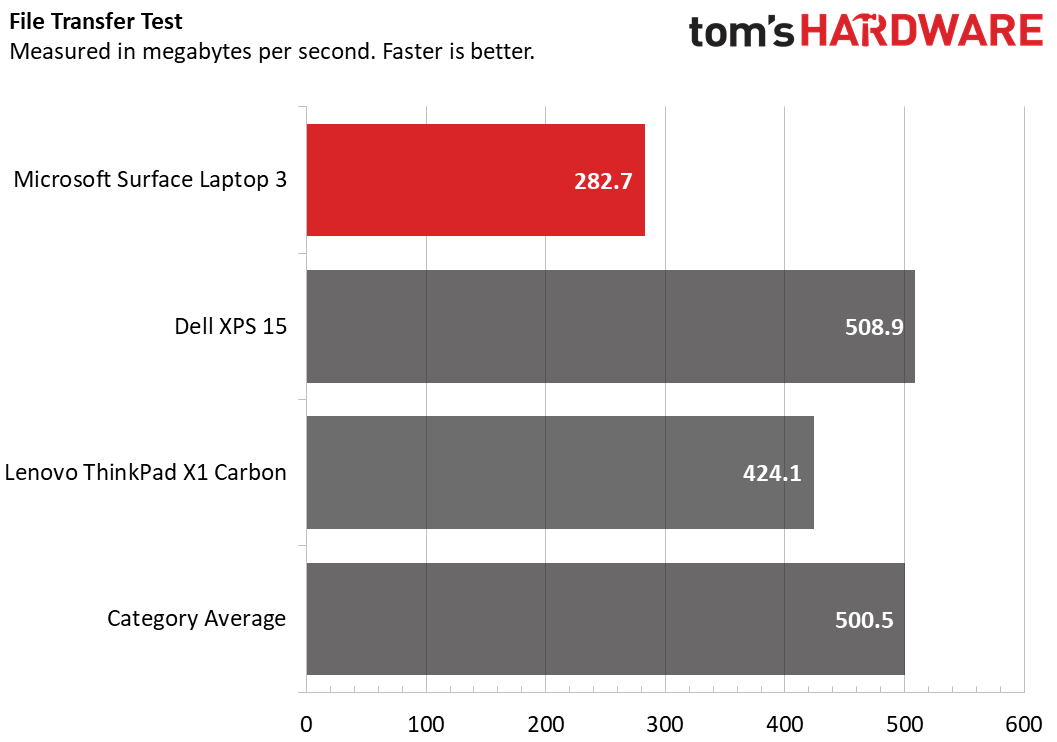
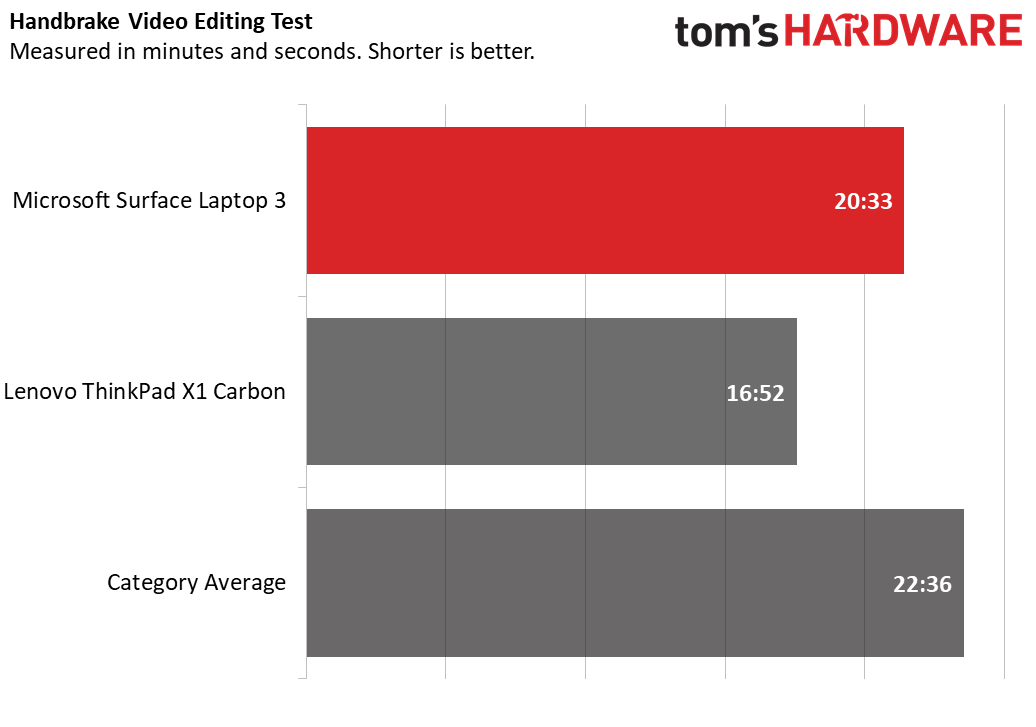
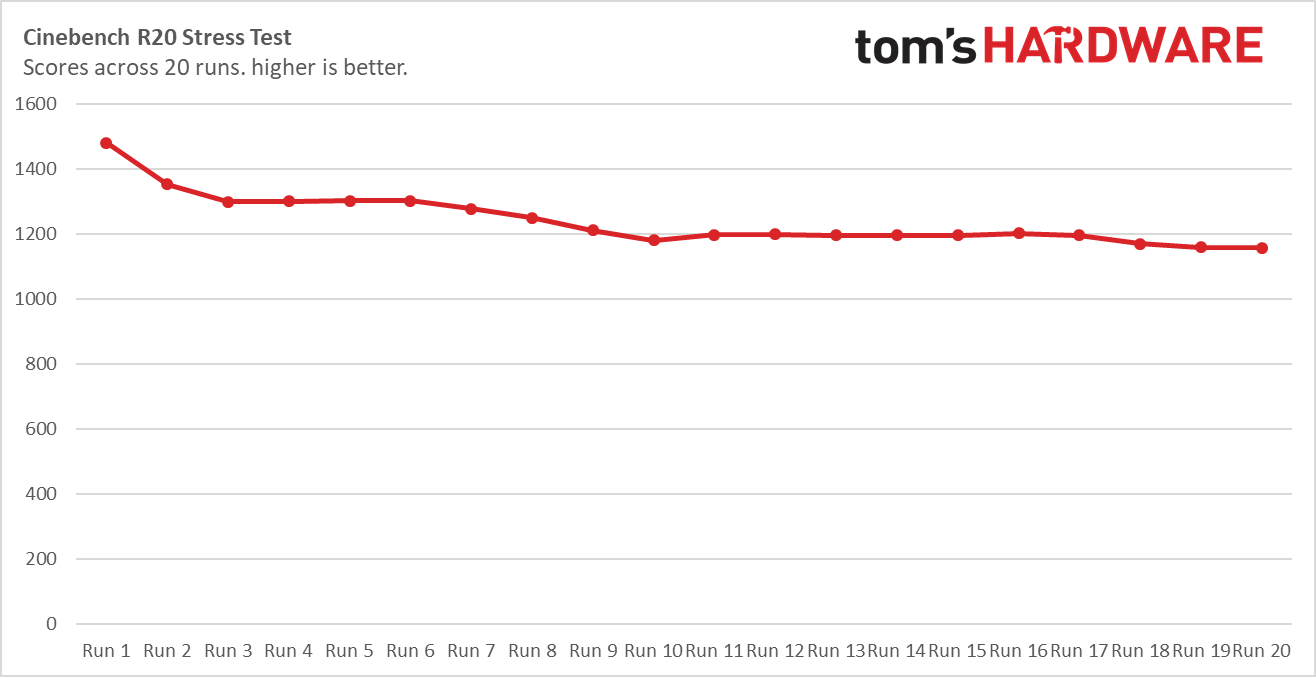
On Geekbench 4.3, the Surface Laptop earned a score of 11,612, which is below the premium laptop average of 15,650. It’s also lower than the ThinkPad X1 Carbon’s Core i5 (15,649) and unsurprisingly, the XPS 15’s Core i9-9900K. That latter notebook is here to compare more for size, not specs.
It took the Surface Laptop 3 a full 18 seconds to transfer 4.97GB of files, a rate of 282.7 MBps. That’s slower than the average (504.6 MBps), as well as both the XPS 15 and ThinkPad X1 Carbon.
On our Handbrake video editing test, it took the Surface 20 minutes and 33 seconds to transcode a 4K video to 1080p. That’s ahead of the average (22:36) but behind a last-gen Intel Core i5, which completed the task in 16:52.
To stress test the Ryzen 5 3580U, we ran Cinebench R20 on a loop 20 times. During the test, the CPU ran at an average clock speed of 2.5 GHz and an average temperature of 61.5 degrees Celsius (142.7 degrees Fahrenheit). The highest score in R20 was on the first run (1480.4). This dropped slightly around run 3 and then to its lowest range at run 9, ending at its lowest score on the final run (1157.2).
Graphics Performance
AMD processors are known for their superior integrated graphics. In this case, the integrated Radeon Vega 9 GPU showed a bit of an edge in low-level gaming.
On the Dirt 3 benchmark, the Surface Laptop 3 hit an average of 56 frames per second. While that’s lower than the premium laptop average of 61 fps, it’s important to remember that that includes some laptops with discrete GPUs. The ThinkPad X1 Carbon ran at 31 fps on a Intel Core i5 with Intel UHD 620 graphics. The XPS 15 we tested was one of those laptops that beat the Vega 9, but it has a discrete Nvidia GTX 1650.

When I played Overwatch (high settings, 1980 x 1200), the game ran between 40 and 50 fps, depending on the heat of the battle. It’s not one of the best gaming laptops, but you can squeeze by with it.
Display
In my opinion, all laptop displays that aren’t primarily for gaming should have a 3:2 aspect ratio. So the Surface Laptop 3 wins points in this reviewer’s book just for that. 3:2 displays are taller than 16:9 screens, so you can see more work vertically when you’re writing, browsing the web, working in spreadsheets or anything else you can think of. Perhaps the only downside is that when watching most videos, there are some black bars above and below them.
When I watched a 1920x1080 trailer for Star Wars: The Rise of Skywalker, Rey’s blue lightsaber reflected against her face and C-3PO’s golden body glowed against an orange and brown background. This panel isn’t the most vivid screen around, but it’s more than serviceable.
Microsoft’s display covers 101% of the sRGB gamut, a bit less than the premium laptop average of 130%. Lenovo’s FHD display measured 109% and the 4K version measured 144%. The Dell’s OLED, again, not the cleanest of comparisons, measured 239%.
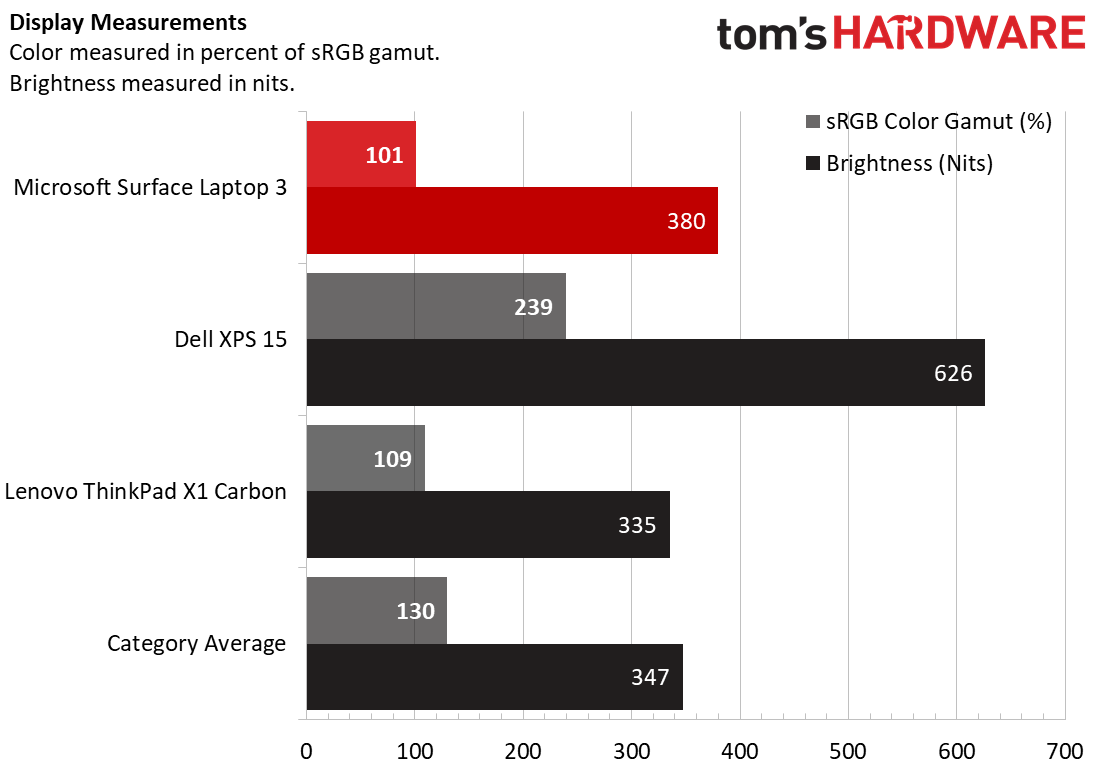
The display is plenty bright at 380 nits, far ahead of the 347-nit premium laptop average. That’s brighter than the ThinkPad X1 Carbon’s FHD display but not it’s 4K option. The XPS 15’s OLED panel, which isn’t as fair of a comparison, is far brighter.
Even though the screen isn’t as lively as some competitors, the aspect ratio makes the display more appealing.
Keyboard and Touchpad
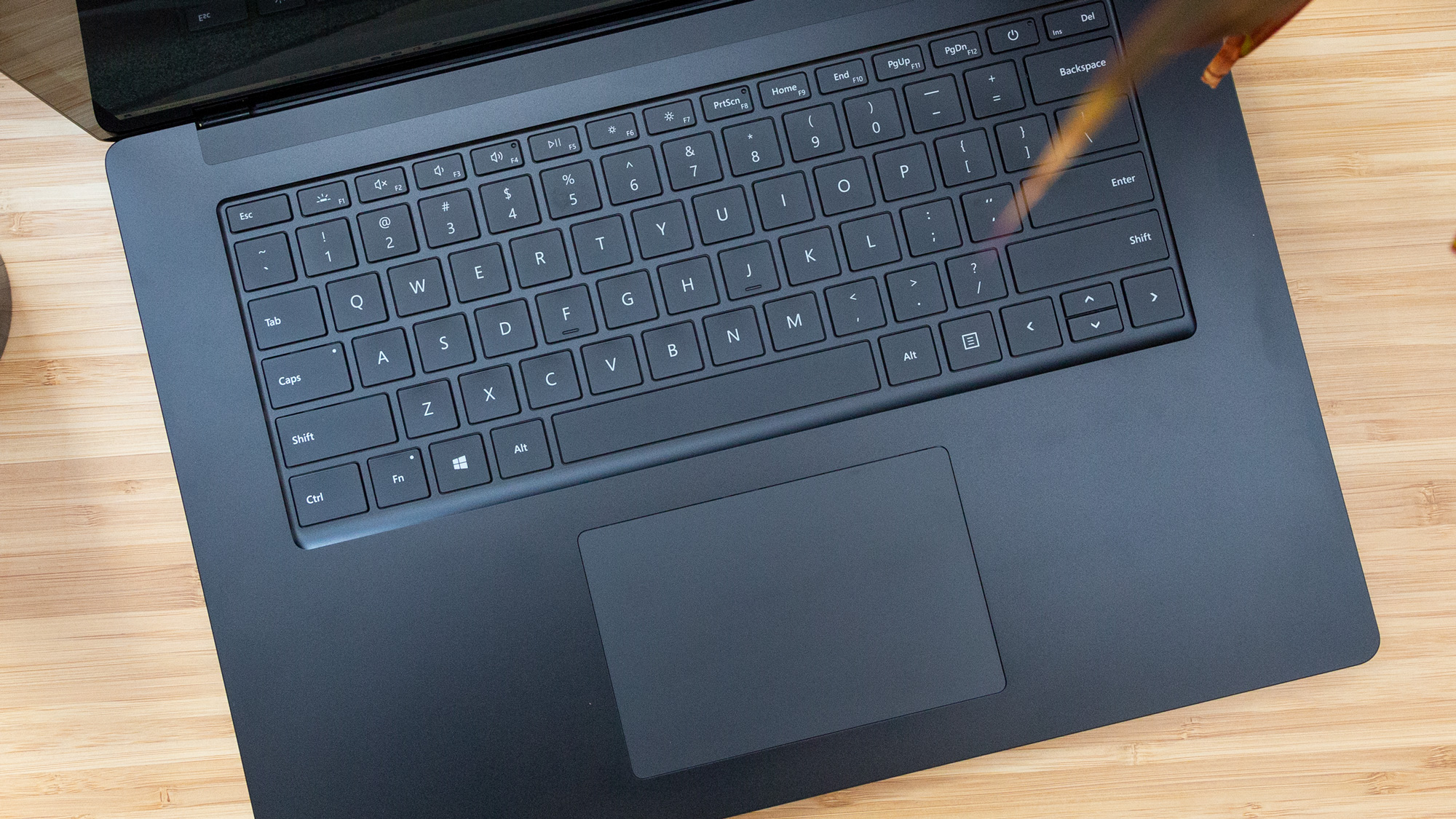
The keyboard on the Surface Laptop 3 is sure to be polarizing. It’s fairly flat, but still offers some bounce. The keycaps are comfortable and easy for my fingers to conform to, though I would have liked more of a click. Some colleagues found the keys to be too shallow. On the 10fastfingers.com typing test, I reached 111 words per minute with a 2 percent error rate, both of which are in my average range.
Unsurprisingly, the company that makes Windows 10 added its own precision drivers to its touchpad. Every gesture, from two-finger scrolling to four-finger tapping performed as expected. And at 4.5 x 3 inches, the touchpad is spacious to the point of feeling luxurious.
Audio
Microsoft’s speakers, tuned with Dolby Audio, are serviceable. While most 15-inch laptops have a bit of extra room for some oomph, The Surface is loud enough to fill a room, but you won’t get any more detail than your average ultraportable. Case in point: I listened to Green Day’s American Idiot, and the guitars, vocals and drums were clear. It was almost impossible, though, to make out the bass.
Connectivity
We often gloss over Wi-Fi, but there are some changes here year-over-year. Namely, most previous Surface devices have used Marvell-based Wi-Fi, which many power users aren’t fans of. Our review unit has a Qualcomm Atheros QCA61x4A.
The 15-inch Surface Laptop 3 supports 802.11ac Wi-Fi (aka Wi-Fi 5), which will be fine for most people. But the Intel-powered 13-inch version supports the next gen 802.11ax (Wi-Fi 6) standard, making it more future proof.
Upgradeability
The Surface Pro 3 is technically upgradeable. Specifically, Microsoft made the Surface Laptop 3 easier to open up to replace the SSD. Surface head Panos Panay even made a point of showing it off at the device’s unveiling.
But the company also suggests that it’s not user upgradeable. Specifically, it wants users to leave an upgrade to Microsoft certified technicians. If you damage something, you’re very likely voiding your warranty here.
If you were to get in, by removing the feet from the laptop and removing screws below it, you would find a 2230 m.2 SSD, a shorter drive than you see in most laptops. It’s hard to come by drives of this size in retail channels right now, but that should fill out as more and more devices use these shorter storage devices.
Battery Life
Unfortunately for Microsoft, the 15-inch Surface Laptop 3’s battery life is a bit below average. It endured for an even 8 hours on our battery test, which continuously browses the web, runs OpenGL tests and streams video over Wi-Fi, all at 150 nits. That’s 15 minutes less than the premium laptop average, and a few minutes behind the Dell XPS 15, but that laptop had an OLED display. Lenovo’s ThinkPad X1 Carbon ran for 9:30 with a 1080p display (though a far worse 5:33 at 4K).
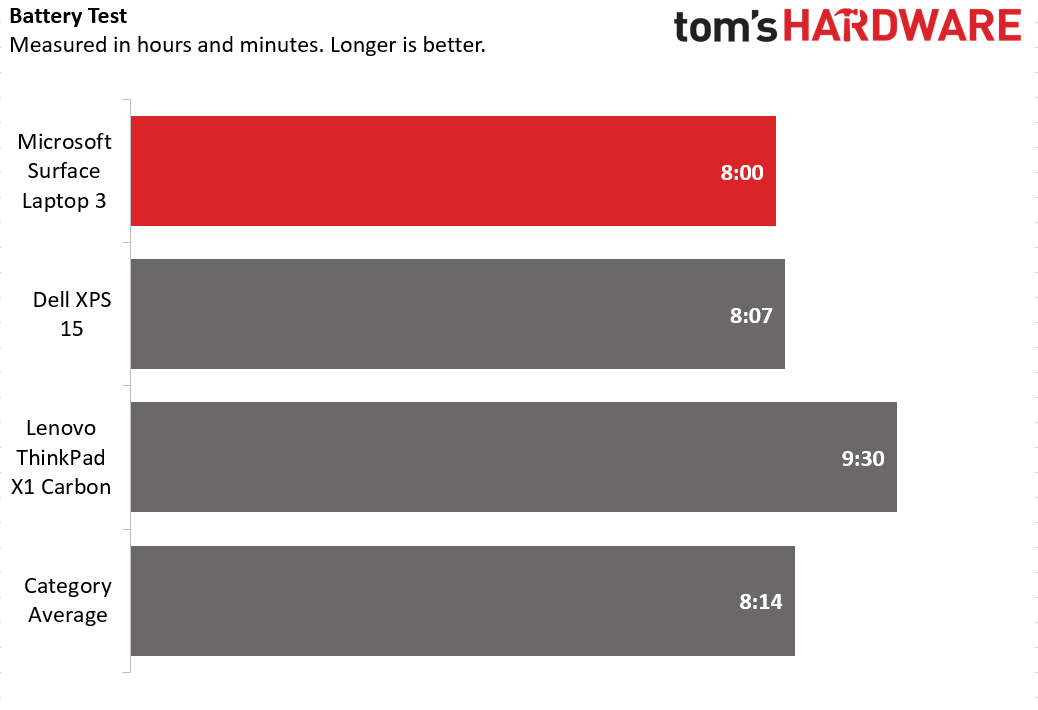
Heat
While running our Cinebench R15 loop, we took heat measurements for skin temperatures. The bottom of the laptop, at its hottest, reached 43.5 degrees Celsius (110.3 degrees Fahrenheit). The touchpad was cool at 28.8 degrees Celsius (83.8 degrees Fahrenheit). The center of the keyboard measured 37.8 degrees Celsius (100 degrees Fahrenheit).
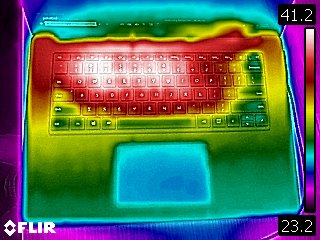
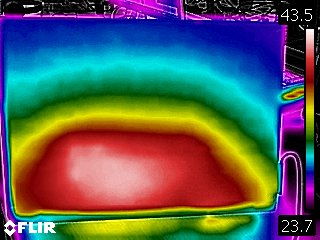
Webcam
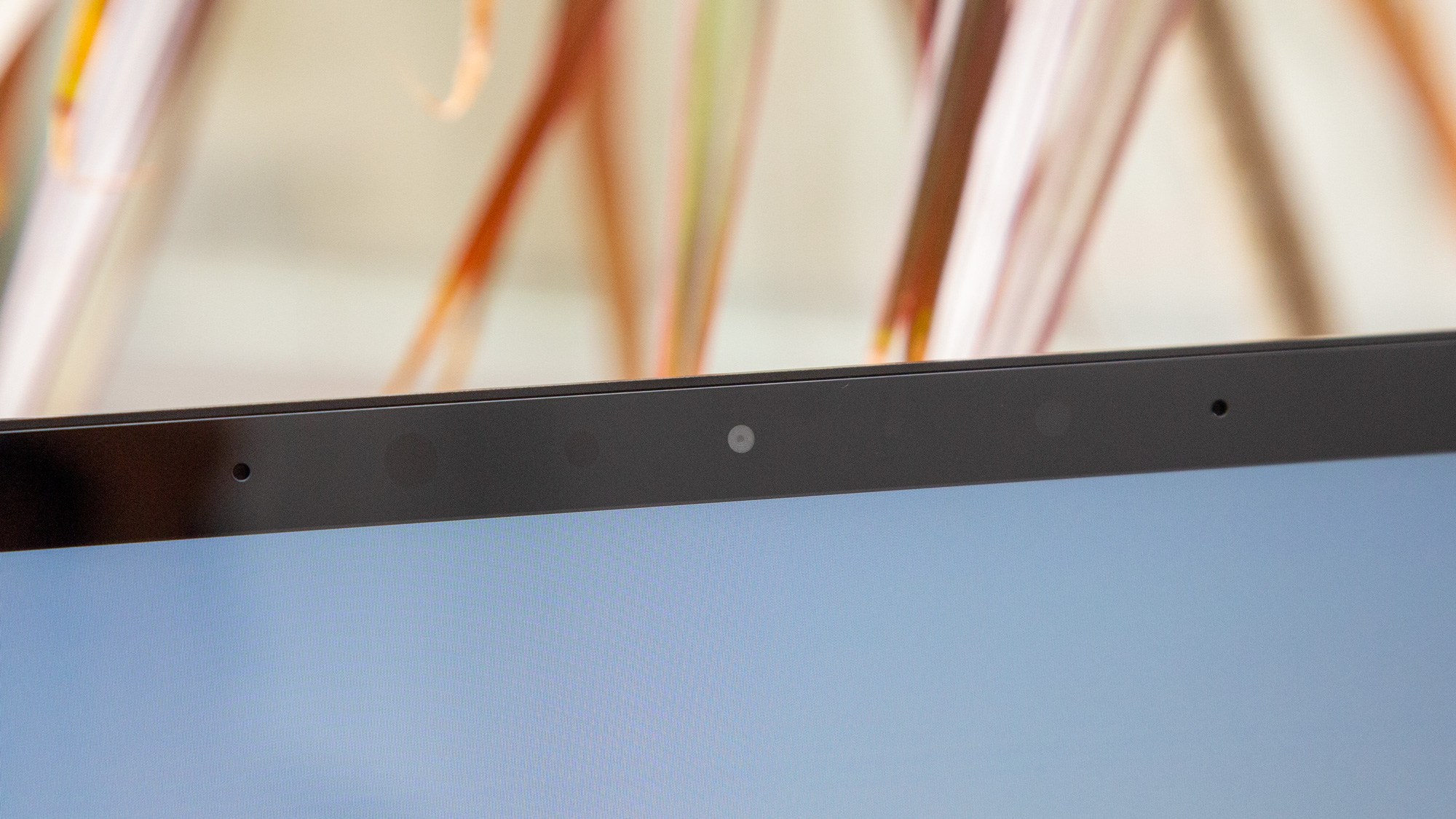
The 720p webcam on the Surface Laptop 3 has an eye for detail. In a shot I took at my desk, it displayed all of the colors in my green, blue gray and yellow shirt correctly, and caught the wrinkles by my eye when I smiled and the hairs on my head.
The Surface Laptop 3 also has infrared to support login for facial recognition via Windows Hello.
Software and Warranty
Microsoft sells the Surface Laptop 3 with a pristine start menu. The only added software is the Surface app, which is a hub for adjusting settings on the Surface Pen, which Bluetooth devices are connected and getting support and warranty information. The company sells the Surface Laptop 3 (15-inch) with a one-year warranty.
Configurations
Our review unit is in a black chassis with an AMD Ryzen 5 3580U, 16GB of DDR-2400 RAM and a 256GB M.2 NVMe SSD and costs $1,699.00.
The base model costs $1,199.00 with the same processor, 8GB of RAM and 128GB of storage. That configuration is only available in platinum. Bumping up to 256GB brings you to $1,499.00. Those are heavy upcharges for just a bump up in SSD storage. Keep in mind that the retail price difference between a 128GB and 256GB SSD these days is often $15-$25. Granted, Microsoft may have to pay more given that they’re using a short drive with limited suppliers, but there’s no way the company isn’t walking away with the vast majority of the $300 price difference as pure profit.
The top-end 15-inch Surface Laptop 3 is $2,099.00 with an AMD Ryzen 7 3780U, 16GB of RAM and a 512GB SSD.
Bottom Line

The Surface Laptop 3 (15-inch) is an attractive 15-inch notebook that’s thin and light enough to take anywhere. For some, getting a display of that size in something so thin and light will be perfect, and those users really don’t need to consider anything else.
If you’re looking for a laptop with more power, that’s where the Dell XPS 15 comes in. It’s just a little bulkier, but you can purchase it with discrete graphics in the form of an Nvidia GTX 1650, a 4K display and twice as much storage as our Surface Laptop 3 for just $50 more as of this writing (or $200 less with an FHD display).
But if you’re someone consuming media more than making it, who simply wants a large display (or you prefer the 3:2 aspect ratio) and the ability to take your laptop anywhere, the Surface Laptop 3 is well worth considering.

Andrew E. Freedman is a senior editor at Tom's Hardware focusing on laptops, desktops and gaming. He also keeps up with the latest news. A lover of all things gaming and tech, his previous work has shown up in Tom's Guide, Laptop Mag, Kotaku, PCMag and Complex, among others. Follow him on Threads @FreedmanAE and BlueSky @andrewfreedman.net. You can send him tips on Signal: andrewfreedman.01
-
jimmysmitty AMD really needs to push their newer CPUs to mobile. Intel heavily invests in there and this is all last gen stuff for them. They are pushing out ther 10nm products which currently perform better than the existing stuff and have massively improved iGPUs.Reply
AMD is not the best option in mobile currently. -
weilin Replyadmin said:The Microsoft Surface Laptop 3 (15-inch) is an attractive, thin 15-inch notebook -- and it finally has USB Type-C. But what about performance and battery life?
Microsoft Surface Laptop 3 (15-inch) Review: AMD Inside : Read more
Psst... Under Specifications, it's 1 USB-C, 1 USB-A, not 2x USB-C.
Also, I think these are USB 3.1 Gen2 (10GB/s) ports? -
AndrewFreedman Replyweilin said:Psst... Under Specifications, it's 1 USB-C, 1 USB-A, not 2x USB-C.
Ack, thanks for the catch. That's being fixed. -
gaborbarla Replyw_barath said:The battery life chart has no scale on the X axis, the vertical graduations are meaningless, and the relative lengths of the lines are meaningless.
As a result, the chart paints a grossly misleading picture, resulting in an impression of poor journalism and poor reviewership, not what I expect from THG.
Please fix it so I can remove this public service notice.
Absolutely. This is very disappointing. -
AndrewFreedman Replyw_barath said:The battery life chart has no scale on the X axis, the vertical graduations are meaningless, and the relative lengths of the lines are meaningless.
You're right - we had an error in Excel. That's regrettable, and it has been fixed. -
refillable Not the best laptop there is. Sure, it might look cooler against other laptops from Dell and Lenovo, but that performance and the battery life you're getting for that just kills it. AMD needs to up their game. Zen+ might still be better than lntel's current gen in desktop, but it's not the case in mobile. It seems that Zen 2 will only achieve parity as opposed to killing it entirely in mobile. I hope they can change my mind.Reply -
jimmysmitty Replyrefillable said:Not the best laptop there is. Sure, it might look cooler against other laptops from Dell and Lenovo, but that performance and the battery life you're getting for that just kills it. AMD needs to up their game. Zen+ might still be better than lntel's current gen in desktop, but it's not the case in mobile. It seems that Zen 2 will only achieve parity as opposed to killing it entirely in mobile. I hope they can change my mind.
The issue is Intel already is pushing 10nm CPUs that are showing decent performance gains. So even if they do put out Zen 2 its not going to be as easy of a battle as it is on desktop. Intel has been doing very well in the mobile market since the Pentium M, the predecessor to Core, and they are not going to give up easily. -
RodroX What are the specs of the other two laptops compared in the article?Reply
What is the performance of Cinebench for those laptops, cause only the Surface results was writen?
I wasn't expecting much from Microsoft anyways. This is like buying a car from Shell, just beacuse they do the fuel doesn't mean they will know how to build a car. -
NightHawkRMX AMD needs to get 7nm to mobile. They have a good Igpu, but Intels new igpus are gaining on them and Intel's 10nm CPUs win hands down.Reply